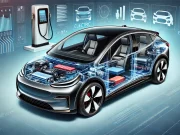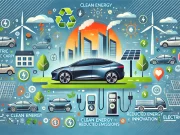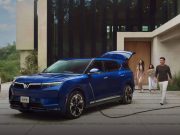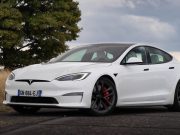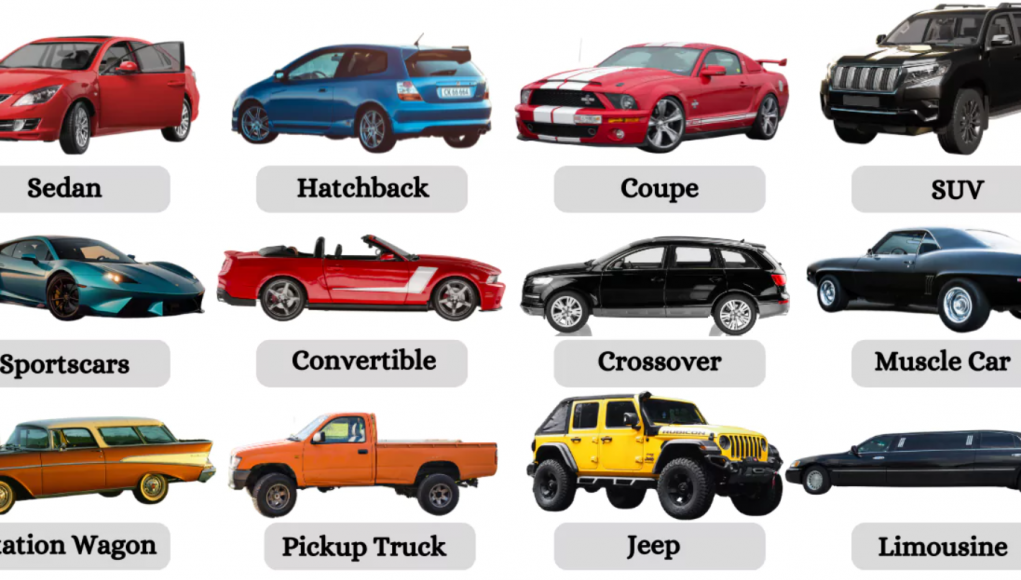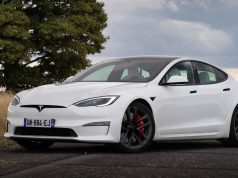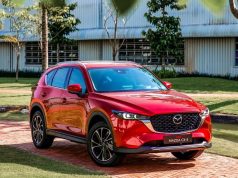Cars come in various types and body styles, each designed to meet specific needs and preferences. Whether you’re a daily commuter, a family person, or an adventure enthusiast, understanding the different car categories can help you make an informed decision. This comprehensive guide delves into the major types of cars, their key features, popular models, and the pros and cons of each, providing you with valuable insights to choose the right vehicle.
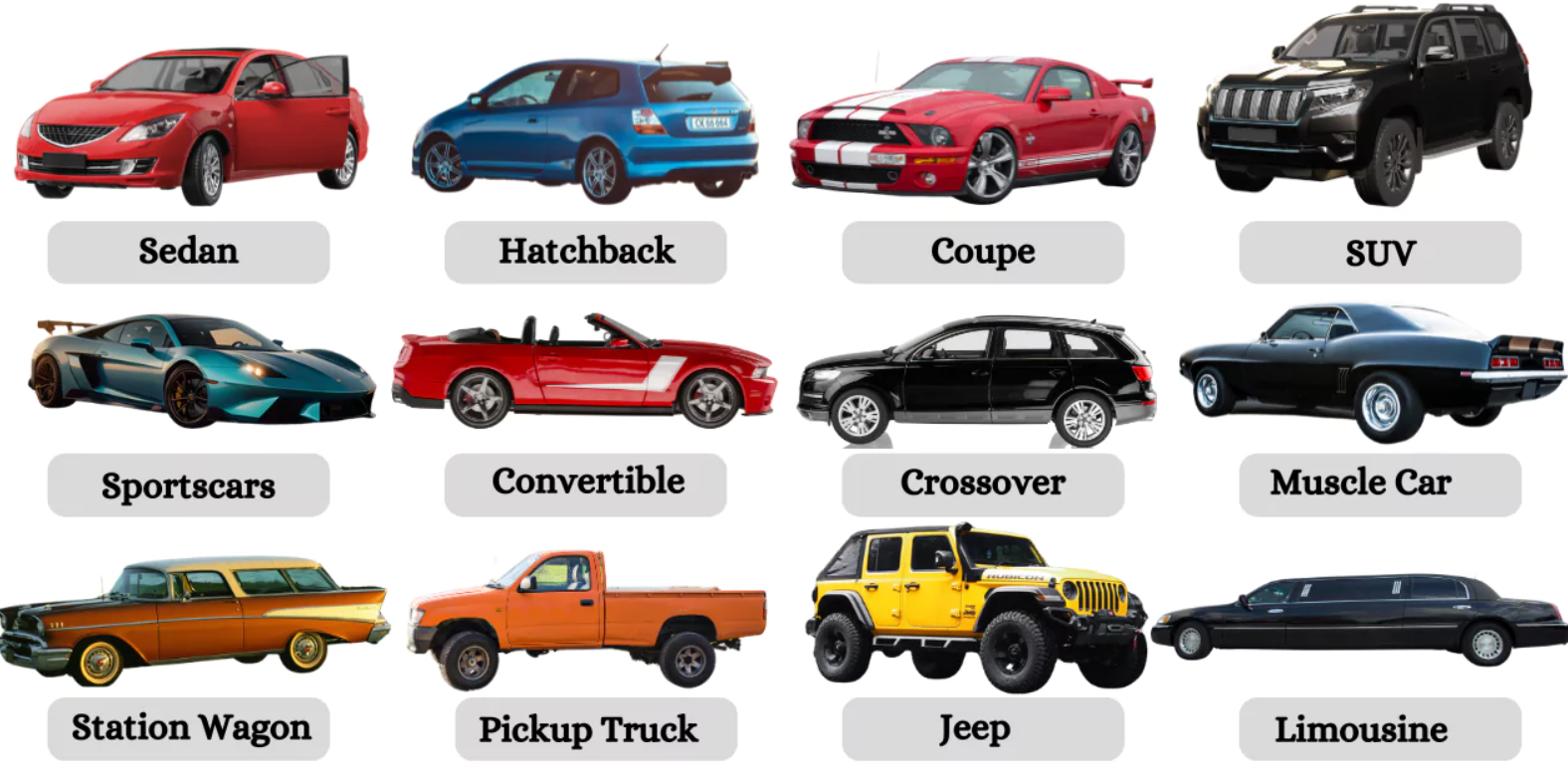
Major Types of Cars
Sedan
Definition:
A sedan is a passenger car in a three-box configuration with separate compartments for the engine, passenger, and cargo. It typically features four doors and a conventional trunk.
Key Features:
- Seating Capacity: Comfortably seats four to five passengers.
- Design Focus: Emphasizes comfort, fuel efficiency, and a smooth ride.
- Practicality: Ideal for city driving and highway cruising.
- Fuel Efficiency: Generally more fuel-efficient due to lighter weight and aerodynamic design.
Popular Models:
- Toyota Camry: Known for its reliability, comfortable interior, and efficient performance.
- Honda Accord: Offers a blend of comfort, technology, and fuel efficiency.
- Mazda 6: Recognized for its stylish design and engaging driving dynamics.
Pros and Cons:
| Pros | Cons |
|---|---|
| – Fuel-efficient and cost-effective to run. | – Limited cargo space compared to SUVs and wagons. |
| – Comfortable seating and smooth ride quality. | – Not suitable for off-road or rugged terrains. |
| – Easier to maneuver and park in urban settings. | – Lower ground clearance can be an issue in snow. |
SUV (Sport Utility Vehicle)
Comprehensive Review: What Does SUV Stand For?
Definition:
An SUV is a robust vehicle combining elements of road-going passenger cars with features from off-road vehicles, such as raised ground clearance and four-wheel drive.
Key Features:
- Versatility: Capable of handling various terrains and weather conditions.
- Seating Capacity: Accommodates five to seven passengers.
- Cargo Space: Offers ample cargo room with foldable rear seats.
- Sizes Available: Comes in compact, mid-size, and full-size variants to suit different needs.
Popular Models:
- Ford Explorer: Features a spacious interior, advanced safety features, and strong towing capacity.
- Mazda CX-5: Known for its stylish design, fuel efficiency, and agile handling.
- Honda CR-V: Offers reliability, comfort, and a roomy cabin.
Pros and Cons:
| Pros | Cons |
|---|---|
| – Spacious interior and cargo area. | – Higher fuel consumption due to size and weight. |
| – Elevated driving position provides better road visibility. | – Can be more challenging to maneuver in tight spaces. |
| – Good off-road and all-weather capabilities. | – Generally higher purchase and maintenance costs. |
CUV (Crossover Utility Vehicle)
Comprehensive Guide to CUV (Crossover Utility Vehicle)
Definition:
A CUV, or crossover utility vehicle, is built on a unibody car platform, combining features of a traditional SUV with the handling and fuel efficiency of a passenger car.
Key Features:
- Design: Blends the practicality of an SUV with car-like driving dynamics.
- Fuel Efficiency: Typically more fuel-efficient than traditional SUVs.
- Comfort: Offers a comfortable ride with a focus on interior quality.
- City-Friendly: Easier to maneuver and park in urban environments.
Popular Models:
- Kia Sportage: Provides a stylish design, user-friendly technology, and good value.
- Toyota RAV4: Known for its reliability, fuel efficiency, and spacious interior.
- Hyundai Tucson: Offers a comfortable ride, ample features, and attractive pricing.
Pros and Cons:
| Pros | Cons |
|---|---|
| – Easier handling and maneuverability. | – Less capable in extreme off-road conditions. |
| – Better fuel economy compared to traditional SUVs. | – Smaller cargo space than larger SUVs. |
| – Comfortable and quiet ride quality. | – May lack towing capacity of full-size SUVs. |
Hatchback
Definition:
A hatchback is a car body configuration with a rear door that swings upward to provide access to a cargo area. The interior can be reconfigured to prioritize passenger or cargo space.
Key Features:
- Versatility: Foldable rear seats increase cargo capacity.
- Compact Size: Ideal for city driving and tight parking spaces.
- Fuel Efficiency: Generally economical due to smaller size and weight.
- Accessibility: Easy loading and unloading of cargo.
Popular Models:
- Volkswagen Golf: Offers a blend of performance, comfort, and practicality.
- Ford Focus: Known for its agile handling and modern technology features.
- Mazda 3 Hatchback: Recognized for its upscale interior and sporty driving experience.
Pros and Cons:
| Pros | Cons |
|---|---|
| – Practical for both passengers and cargo. | – Limited cargo space compared to SUVs when seats are up. |
| – Economical to buy and run. | – Less suitable for large families. |
| – Easy to park and navigate in urban areas. | – Not designed for heavy-duty performance or towing. |
Coupe
Definition:
A coupe is a two-door car with a fixed roof, typically designed with a sporty appearance and performance-oriented features.
Key Features:
- Design: Sleek and stylish exterior with a focus on aesthetics.
- Performance: Often equipped with more powerful engines for enhanced driving dynamics.
- Seating: Usually seats two to four passengers, with limited rear-seat space.
- Luxury Features: Higher-end materials and technology options.
Popular Models:
- Ford Mustang: An iconic sports car known for its performance and muscle car heritage.
- BMW 4 Series: Combines luxury with sporty handling and advanced technology.
- Audi A5: Offers a refined interior, smooth ride, and elegant design.
Pros and Cons:
| Pros | Cons |
|---|---|
| – Sporty performance and handling. | – Limited rear-seat space and accessibility. |
| – Stylish and attention-grabbing design. | – Higher insurance and maintenance costs. |
| – Enhanced driving experience for enthusiasts. | – Less practical for daily family use. |
Convertible
Definition:
A convertible is a car with a roof structure that can be ‘converted’ to allow open-air or enclosed driving.
Key Features:
- Retractable Roof: Can be a soft-top or hard-top, operated manually or electronically.
- Style and Enjoyment: Emphasizes pleasure driving and style.
- Seating: Typically accommodates two to four passengers.
- Seasonal Use: Best enjoyed in favorable weather conditions.
Popular Models:
- Mazda MX-5 Miata: Celebrated for its lightweight design and fun-to-drive character.
- Ford Mustang Convertible: Combines muscle car performance with open-air driving.
- BMW Z4: Offers luxury features and dynamic handling.
Pros and Cons:
| Pros | Cons |
|---|---|
| – Enjoyable open-air driving experience. | – Less practical due to limited cargo space. |
| – Stylish and unique appearance. | – Higher cost and potential maintenance of roof mechanism. |
| – Ideal for leisure and pleasure trips. | – Reduced structural rigidity compared to fixed-roof cars. |
Pickup Truck
Definition:
A pickup truck is a light-duty truck having an enclosed cab and an open cargo area with low sides and tailgate.
Key Features:
- Utility: Designed for hauling and towing heavy loads.
- Durability: Built to withstand rugged use and tough conditions.
- Variety: Available in various sizes and configurations (light, medium, and heavy-duty).
- Off-Road Capability: Many models come with four-wheel drive and off-road features.
Popular Models:
- Ford F-150: Known for its strength, versatility, and advanced technology.
- Chevrolet Silverado: Offers robust performance and a range of engine options.
- Ram 1500: Recognized for its comfortable ride and upscale interior.
Pros and Cons:
| Pros | Cons |
|---|---|
| – Excellent towing and hauling capabilities. | – Lower fuel efficiency due to size and weight. |
| – Versatile for both work and personal use. | – Larger size can make parking and maneuvering challenging. |
| – Durable and long-lasting build. | – Higher emissions compared to smaller vehicles. |
Minivan
Definition:
A minivan is a passenger vehicle that combines the spaciousness of a van with the comfort of a car, designed primarily for transporting people.
Key Features:
- Seating Capacity: Can seat seven to eight passengers comfortably.
- Family-Friendly: Features like sliding doors, ample storage, and entertainment systems.
- Space Utilization: Flexible seating arrangements and significant cargo space.
- Comfort: Emphasizes ride comfort and convenience features.
Popular Models:
- Honda Odyssey: Offers reliability, safety features, and a comfortable interior.
- Toyota Sienna: Known for its all-wheel-drive option and advanced technology.
- Chrysler Pacifica: Features a plug-in hybrid option and upscale amenities.
Pros and Cons:
| Pros | Cons |
|---|---|
| – Ideal for large families and group travel. | – Less stylish and sporty compared to SUVs and cars. |
| – Spacious interior with versatile seating. | – Larger size may be difficult to maneuver in tight spaces. |
| – Comfortable ride with family-oriented features. | – Typically lower fuel efficiency. |
Electric Vehicle (EV)
Definition:
An electric vehicle operates on an electric motor instead of an internal combustion engine, using energy stored in rechargeable batteries.
Key Features:
- Environmentally Friendly: Zero tailpipe emissions contribute to reduced pollution.
- Running Costs: Lower operating costs due to electricity being cheaper than gasoline.
- Performance: Instant torque provides quick acceleration.
- Technology: Equipped with advanced features and connectivity options.
Popular Models:
- Tesla Model 3: Praised for its long-range capability, performance, and autonomous features.
- Nissan Leaf: Offers affordability and practicality for everyday use.
- Chevrolet Bolt: Known for its impressive range and compact design.
Pros and Cons:
| Pros | Cons |
|---|---|
| – Reduced environmental impact. | – Limited charging infrastructure in some areas. |
| – Lower maintenance due to fewer moving parts. | – Higher upfront cost compared to conventional cars. |
| – Quiet and smooth operation. | – Range anxiety due to battery limitations. |
Popular Car Body Styles
Understanding car body styles helps in identifying the vehicle that best suits your aesthetic preferences and functional needs.
Sedan
Characteristics:
A sedan features a three-box design with separate compartments for the engine, passengers, and cargo. It typically has four doors and a conventional trunk.
Example Models:
- Honda Civic: Compact sedan known for reliability and efficiency.
- BMW 3 Series: Luxury sedan offering performance and advanced features.
SUV
Characteristics:
SUVs have a taller body, higher ground clearance, and often feature four-wheel drive, making them suitable for a variety of terrains.
Example Models:
- Jeep Grand Cherokee: Combines off-road capability with luxury.
- Toyota Highlander: Offers spacious seating and a comfortable ride.
Hatchback
Characteristics:
A hatchback has a rear door that swings upward to access the cargo area, with the interior space adaptable for passengers or cargo.
Example Models:
- Hyundai i20: Compact hatchback with modern features.
- Kia Rio: Offers value for money with a practical design.
Coupe
Characteristics:
Coupes are characterized by their two-door design, sporty appearance, and often a sloping roofline.
Example Models:
- Chevrolet Camaro: Muscle car with strong performance.
- Mercedes-Benz C-Class Coupe: Luxury coupe with elegant styling.
Convertible
Characteristics:
Convertibles feature a retractable roof, allowing for open-air driving when desired.
Example Models:
- Porsche 911 Cabriolet: High-performance sports car with luxury features.
- Audi A3 Convertible: Combines compact size with premium amenities.
Wagon
Characteristics:
Wagons have an extended roofline and rear cargo area, providing more space without the bulk of an SUV.
Example Models:
- Volvo V60: Known for safety and Scandinavian design.
- Subaru Outback: Offers all-wheel drive and off-road capability.
Car Models and Popularity
Most Popular Models in the US
- Ford F-Series: The best-selling vehicle in the US for decades, appreciated for its durability, performance, and versatility.
- Toyota Camry: Favored for its reliability, comfort, and fuel efficiency in the midsize sedan segment.
- Honda Civic: Popular compact car known for its economy, reliability, and resale value.
Popular EV Models
- Tesla Model 3: Leading the electric car market with advanced technology, impressive range, and performance.
- Chevrolet Bolt: Provides an affordable entry into electric vehicles with a practical range and compact size.
Luxury Car Models
- Mercedes-Benz E-Class: Offers a blend of luxury, performance, and cutting-edge technology in the executive sedan class.
- BMW 5 Series: Known for its dynamic driving experience and luxurious interior.
Detailed Comparison: Mercedes-Benz C300 AMG 2024 vs. Porsche Macan 2019
Pros and Cons of Different Car Types
Understanding the advantages and disadvantages of each car type can help you prioritize features that are most important to you.
| Car Type | Pros | Cons |
|---|---|---|
| Sedan | – Fuel-efficient and affordable. – Comfortable for daily commuting. – Easier to handle and park in urban areas. |
– Limited cargo space. – Not suitable for off-road driving. – Lower seating position may offer less visibility. |
| SUV | – Spacious with ample cargo and passenger space. – Elevated driving position for better road view. – Good for off-road and adverse conditions. |
– Higher fuel consumption. – More expensive to purchase and maintain. – Can be bulky and harder to park. |
| CUV | – Combines the best of cars and SUVs. – Better fuel efficiency than traditional SUVs. – Easier to maneuver in cities. |
– Less capable off-road compared to SUVs. – May have less towing capacity. – Smaller cargo space than full-size SUVs. |
| Hatchback | – Versatile cargo space. – Compact size ideal for city driving. – Generally fuel-efficient and affordable. |
– Limited rear space for passengers. – Not suitable for heavy cargo. – May lack advanced features found in larger vehicles. |
| Coupe | – Sporty and stylish design. – Enhanced performance and handling. – Ideal for enthusiasts. |
– Limited seating and cargo space. – Higher insurance costs. – Less practical for families. |
| Convertible | – Offers open-air driving experience. – Stylish and unique. – Fun to drive in good weather. |
– Less practical due to limited space. – Higher maintenance costs. – Not ideal in harsh weather conditions. |
| Pickup Truck | – Excellent for towing and hauling. – Durable and rugged. – Versatile for work and recreation. |
– Poor fuel economy. – Difficult to park in tight spaces. – Higher emissions. |
| Minivan | – Spacious and comfortable for families. – Practical features like sliding doors. – Flexible seating arrangements. |
– Less stylish compared to SUVs. – Larger size can be challenging to maneuver. – Not fuel-efficient. |
| Electric Vehicle (EV) | – Environmentally friendly with zero emissions. – Lower operating costs. – Smooth and quiet operation. |
– Higher initial purchase price. – Limited charging infrastructure. – Battery range limitations. |
Conclusion and Recommendations
Choosing the Right Vehicle
Selecting the perfect car depends on your individual needs, preferences, and lifestyle. Consider the following when making your decision:
- For Families: SUVs and minivans offer the space, comfort, and safety features ideal for family transportation.
- For Daily Commuters: Sedans, hatchbacks, and electric vehicles provide fuel efficiency and ease of use in urban environments.
- For Adventure Enthusiasts: SUVs and pickup trucks with off-road capabilities are suitable for outdoor activities and rugged terrains.
- For Luxury Seekers: Luxury sedans and coupes offer premium features, comfort, and performance.
Expert Opinion from Worrycars
At Worrycars, we understand that the automotive landscape is vast and ever-evolving. Our experts recommend evaluating your primary needs—be it cargo space, fuel efficiency, performance, or technology features—before narrowing down your options. It’s also important to consider long-term costs such as maintenance, fuel, and depreciation.
For instance, if you’re environmentally conscious and have access to charging stations, an electric vehicle like the Tesla Model 3 might be an excellent choice. Alternatively, if you require versatility and space for a growing family, the Toyota Highlander SUV could be ideal.
Remember, the best car for you is one that fits your lifestyle, budget, and personal preferences.
Comprehensive Review of Lexus GX550 at 6.25 Billion VND
FAQs
What’s the difference between an SUV and a CUV?
An SUV is typically built on a truck chassis, offering robust off-road capabilities and towing capacity, while a CUV (Crossover Utility Vehicle) is built on a car platform (unibody construction), providing better fuel efficiency and handling similar to a passenger car. SUVs are generally larger and more rugged, whereas CUVs offer a balance between size, comfort, and efficiency.
Which car type is best for fuel efficiency?
Sedans, hatchbacks, and compact cars are generally more fuel-efficient due to their lighter weight and smaller engines. Electric vehicles offer the highest efficiency since they use electricity instead of gasoline. Hybrids and plug-in hybrids are also excellent choices for fuel economy.
What is the most popular car model in the US?
The Ford F-Series, particularly the F-150 pickup truck, has been the best-selling vehicle in the US for decades. Its popularity stems from its versatility, reliability, and the ability to meet both personal and commercial needs.
Are electric vehicles worth the higher cost?
Electric vehicles have a higher upfront cost but can offer savings over time through lower fuel and maintenance expenses. They are also environmentally friendly, producing zero tailpipe emissions. If you have access to charging infrastructure and are looking for long-term cost savings and environmental benefits, an EV can be a worthwhile investment.
This comprehensive guide aims to equip you with the knowledge to navigate the diverse world of automobiles. By understanding the different car types, body styles, and popular models, you can confidently choose a vehicle that best suits your needs and enhances your driving experience.

